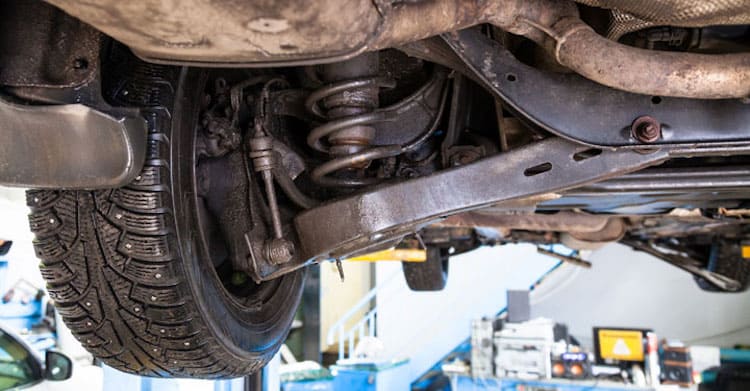Have you ever driven on a bumpy road or railroad tracks at a fairly high speed and wondered how your vehicle is able to stay intact? Chances are you had no idea that your vehicle’s suspension system was doing a lot of work to not only keep the ride as smooth as possible but also to make sure all four of your tires remained in contact with the road surface.
What is a Suspension System?
Simply put, your vehicle’s suspension system is what supports the weight of your vehicle, and maintains traction, even weight distribution, and provides steering stability during driving or turning.
Because all roads have imperfections, your vehicle’s suspension system plays an important role in the overall safety, comfort, and performance of your vehicle.
The suspension system is made up of two main components – springs and dampers. These are explained in the chart below:
Component(s) Function(s)
Springs The function of springs is to compensate for the irregularities in the road surface, as well as support additional weight on the vehicle. Springs also help your vehicle stay level at a pre-determined height from the ground.
As you drive across various road surfaces your vehicle’s springs will absorb the bumps on the road. Every vehicle suspension has a variety of different springs, which include:
Leaf
Coil
Torsion
Dampers While springs are designed to absorb the bumps, dampers control the “up and down” and “side to side” movement of a vehicle. Without a damper, the vehicle would bounce until all of the absorbed energy within the spring has dissipated. Like springs, there are a variety of dampers in your vehicle’s suspension system, which include:
Shock absorbers
Struts
Anti-sway Bars
Common Problems of Suspension Systems
Our vehicle’s suspension system takes a lot of constant abuse from the road. That ongoing wear and tear to its components can eventually cause problems for the suspension system.
| Problem Area | Symptoms |
|---|---|
| Shock absorbers contain fluid to help damper the bouncing of your vehicle. When there is a fluid leak, the shock absorbers can no longer perform effectively to control the bouncing. | Bouncing up and down of the vehicle Shaking on rough road surfaces |
| The struts are a hard-working component of your vehicle’s suspension system that help control your vehicle’s body movement, maintain good tire contact with the road surface, and absorb bumps and jolts from the road. If your driving conditions subject your vehicle to a lot of rough road surfaces, struts can wear down over time. | Cupping on tires Bottoming out of the suspension on rough roads or when backing out of the driveway Swaying or rocking of the vehicle body on turns or in strong winds |
| Ball joints are what attach the suspension to the wheels of the vehicle. They are also subjected to the friction and shock up movement during driving and can wear down with frequent rough driving conditions. | Squeaking or creaking during turns |
| Your vehicle springs help to support the weight of the vehicle. If they are worn or broken, they are unable to provide even support which results in sagging. | One corner of your vehicle sits lower than the others Clunking sound when driving over bumps |
| Misaligned wheels can lead to faster wear and tear of your tire treads and is usually a factor in a suspension issue. Proper wheel alignment helps control the steering and health of your tires. | Excessive wearing of treads Steering wheel shakes or there is unusual pull of the steering wheel in one direction when driving over rough surfaces |
If you are experiencing any of the symptoms noted above, we advise you to bring your vehicle into Shade Tree Garage in Morristown, New Jersey, for a full inspection of the suspension system. Neglecting suspension issues can not only reduce the overall performance of your vehicle, they can easily become a safety hazard if not corrected. Contact us today to schedule your appointment.

